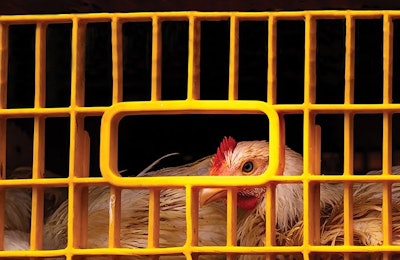
A constant issue for poultry processing plants is the number of downgraded carcasses or rejects due to poor handling of birds during harvesting and transport.
Rough handling and stress can lead to broilers arriving at the processing plant with damaged wings and scratches, among other issues, and ultimately lead to lower output.
Taking a different approach to how birds are reared, however, could reduce this type of damage dramatically and make rearing and pre slaughter much easier.
Movement controls
Typically, during broiler harvesting poultry houses are divided into sections to reduce bird movement. The results of this simple technique are proven – less harm is done to birds due to the flock becoming less agitated.
This movement restriction could be extended back to when chicks first arrive on the farm. Chicks arrive crated and they could simply be kept in larger crates for the duration of the rearing period, only being taken out once they reach the processing plant. This would remove the need for the harvesting team to handle them directly, so minimizing bleeds, bruises and scratches.
While the approach may seem surprising, some farms already reduce broiler movement within the poultry house through the use of temporary dividers.
These large, plastic containers, measuring almost the width of a standard trailer and 2 to 4 meters long, could be distributed throughout the poultry house, leaving strategic passageways through them for performance evaluation during inspections. A central avenue is recommended with perimeter walkways along the sidewalls, however, using advanced technologies could reduce the space given over to these walkways.
Keeping birds in spaces that are smaller than those that are currently employed results in greater control but it could also result in several other benefits, for example, facilitating weighing, clearing the house and the removal of dead birds.

Harvesting could be easier with the entire flock ready crated. | Eduardo Cervantes López/ WATT Global Media
Simplified harvesting
When the time comes to harvest the birds, rather than hiring an entire harvesting team, all that would be needed would be a forklift truck and two workers.
Crates would be taken out of the poultry house and stacked before being lifted onto the truck in the usual way. The load can be secured with the same plastic ties that are currently used, helping to prevent movement and birds from being harmed.
This approach would bring a number of benefits, including reducing the stress experienced by birds due to a more peaceful harvesting process and less exposure to the forklift trucks, as well as reducing the time needed to collect birds and load them on to the trailer.
Unloading at the plant
With crates as wide as a standard trailer, and measuring 2 or 4 meters long, a 40-foot trailer would be able to deliver 3 or 6 stacks of filled crates.These would be unloaded in the usual way with crates moved via forklift and delivered to a pair of workers who move them on to a conveyor belt.
The boxes then travel to a turntable with a slight slope which will gently tip the birds out of the boxes and on to conveyor belts to be transported for processing. Boxes, once empty, can be washed and disinfected prior to being returned to the farm.
Raising birds in this way would not only result in a reduction of rejects due to wing flapping and scratching, but also enormously reduce the level of stress broilers experience. Additionally, fewer harvesting workers would be needed and those that are employed would be less likely to be injured as they would not come into direct contact with the birds.
Processing plants would no longer need huge structures to hold the numerous crates that they currently handle and the number of Grade A birds would rise, increasing yield and raising competitiveness.

















